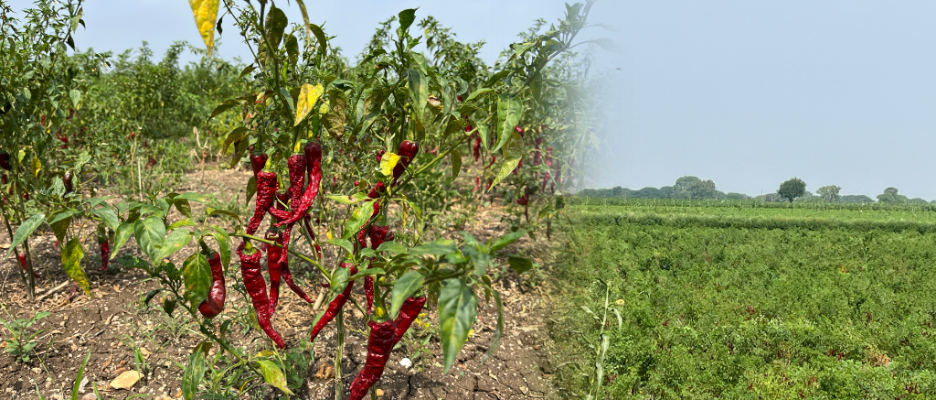
The Dying Red Fields - And Why YOU Should Bother
Share
A short detour on the road from Bangalore to Goa just before Hubbali leads one to the village of Kundagol. The fields on both sides of the road suddenly turn red, fuming with acres and acres of Red Chilli Plantations welcoming your arrival at the birthplace of the famous Kaddi Chilli. Kaddi Chilli also known as the Byadgi KDL derives its name from this very village - Kundagol - abbreviated to KDL. Farmers in Kundagol and neighboring villages in the Gadag district possess unique expertise in cultivating Byadgi chilies without the use of harsh chemical inputs. The terrain in the Gadag district boasts black soil farms with excellent water retention capabilities and high fertility due to rich organic matter, this gives the Byadagi KDL its rich dark red, almost chocolaty, colour. Farmers in this region heavily rely on monsoons to nurture a high-quality crop. Any delays or excessive rainfall can devastate the crop, leading to zero yield. In the local language, Kannada, this region is known as "Bayaluseeme."
Keeping it alive:
Farmers in this region typically reserve a portion of the previous year's harvest to use the seeds for the upcoming sowing season. This practice ensures the authenticity and fundamental traits of the chilies. This is in stark contrast to hybrid chilli variants that are flooding the market today such as Syngenta whose seed comes from company owned seed stores and various other distribution channels. The convenience and accessibility of these hybrids often lead farmers to choose them over native/heirloom varieties.
Sowing commences by opening the carefully stored chili pods and sowing the seed when the monsoon is approaching, usually between June and August and based on the weather forecast. Adequate rainfall, with at least one shower every 15 days during the monsoon is crucial for healthy crop growth. Throughout this phase, the crops combat common plant diseases like leaf curling and infestation. Roughly 2 to 3 months after sowing, green chili peppers begin their emergence. Over time, they shift from their initial green color to a reddish (chocolate-colored) hue, a crucial aspect since Indian culinary traditions greatly value this deep red shade for a multitude of dishes including curries, sambar, pickles, and more. The chili peppers are left on the plant to dry, requiring hot weather conditions to achieve a wrinkled texture. The defining feature of an authentic Byadgi KDL chili is its highly wrinkled dark-red appearance, Low Pungency (10K to 12K Scoville Heat Units), High Natural Colour (ASTA value of 225+) and a Unique flavor (this really cannot be quantified).
Farmers in the Gadag district refrain from using harsh poison grade chemicals for crop protection especially for Byadgi KDL Chilli, resulting in a healthier and more flavorful produce.
But … KDL is Dying
Not just KDL, this is true for all native varieties of Indian Spices. Every year we see a drop in KDL’s area under cultivation as well as its supply that comes to the APMC market. Despite the high price that KDL attracts, the low yield per acreage and the risk of crop destruction (as it is cultivated without harsh chemicals for pest management) is making farmers switch to the foreign hybrid variants or alternate crops. In addition, KDL sells at nearly Rs 600 per KG while other variants that most FMCG companies use for making Chilli Powder would sell from anywhere between Rs 100 to Rs 200 per KG. Unless there's a discerning consumer base, KDL may face extinction in the Bayaluseeme region within approximately 5 years plus minus one or two years.
At FreshGround, we procure this indigenous Byadgi KDL, ensuring consumers nationwide experience the authentic Byadgi KDL chili without any blending. Our mission is to conserve and popularize native varieties, empowering consumers to make informed choices when purchasing their produce. We are counting on YOU to be that discerning customer who reads the label before buying and to help our native varieties live.
Signing Off
Ramakrishna Melgiri
Ramakrishna comes from a family of Spice Merchants. He is also the Co-Founder of FreshGround

1 comment
lovely read. sustainability has a cost to it, it is welcoming to see your team passionately chasing it by trying to save the native.